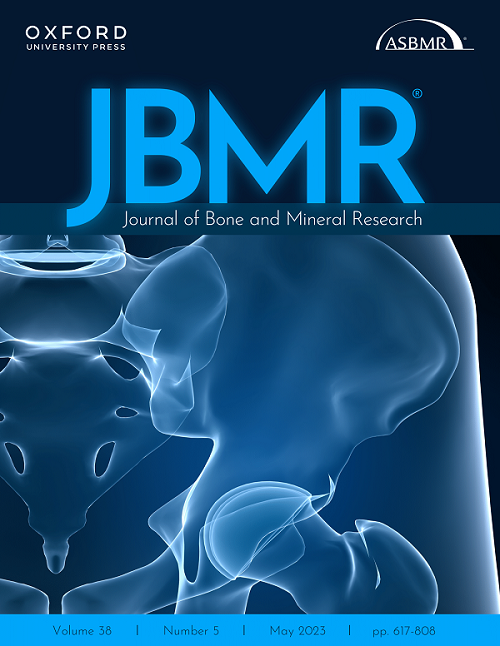Seong Hee Ahn, You Jin Lee, Seongbin Hong, Jung Wee Park, Ye Jhin Jeon, Bit-Na Yoo, Yong-Chan Ha, Jean Kyung Bak, Ha Young Kim, Young-Kyun Lee
求助PDF
{"title":"癌症术后甲状旁腺功能减退患者骨折风险的韩国全国性队列研究","authors":"Seong Hee Ahn, You Jin Lee, Seongbin Hong, Jung Wee Park, Ye Jhin Jeon, Bit-Na Yoo, Yong-Chan Ha, Jean Kyung Bak, Ha Young Kim, Young-Kyun Lee","doi":"10.1002/jbmr.4871","DOIUrl":null,"url":null,"abstract":"<div>\n \n <p>Postoperative hypoparathyroidism (PO-hypoPT) is an uncommon complication of total thyroidectomy in thyroid cancer patients. Although long-term hypoPT causes characteristic changes in bone metabolism, the risk of fractures in hypoPT remains inconclusive. We investigated the risk of fractures in Korean thyroid cancer patients with PO-hypoPT. This was a retrospective cohort study using data from the Korea Central Cancer Registry and Korean National Health Insurance Service. We analyzed 115,821 thyroid cancer patients aged ≥18 years, who underwent total thyroidectomy between 2008 and 2016. The risk of any fractures, including vertebral, hip, humerus, and wrist fractures, according to parathyroid function after total thyroidectomy, was analyzed using the multivariable Cox proportional hazard model. The PO-hypoPT and preserved parathyroid function groups included 8789 (7.6%) and 107,032 (92.4%) patients, respectively. Over a mean follow-up duration of 4.8 years, 159 (1.8%) and 2390 (2.2%) fractures occurred in the PO-hypoPT and preserved parathyroid function groups, respectively. The risk of any fractures was significantly lower in the PO-hypoPT group than in the preserved parathyroid function group (hazard ratio [HR] = 0.83; 95% confidence interval [CI] 0.70–0.98; <i>p</i> = 0.037) after adjusting for confounders. Regarding the fracture site, only the risk of vertebral fractures was significantly lower in the PO-hypoPT group compared with the preserved parathyroid function group (HR = 0.67; 95% CI 0.47–0.96; <i>p</i> = 0.028) after adjusting for confounders. Subgroup analyses showed that bone mineral density measurements and calcium supplementation interacted with the relationship between PO-hypoPT and the risk of any fractures (<i>p</i> for interactions = 0.010 and 0.017, respectively). PO-hypoPT was associated with a lower risk of fractures in thyroid cancer patients, especially at the vertebra. The relatively low bone turnover caused by PO-hypoPT and appropriate management for PO-hypoPT with active vitamin D and calcium may prevent the deterioration of skeletal health in thyroid cancer patients who can easily be exposed to long-term overtreatment with levothyroxine. © 2023 American Society for Bone and Mineral Research (ASBMR).</p>\n </div>","PeriodicalId":185,"journal":{"name":"Journal of Bone and Mineral Research","volume":"38 9","pages":"1268-1277"},"PeriodicalIF":5.1000,"publicationDate":"2023-06-20","publicationTypes":"Journal Article","fieldsOfStudy":null,"isOpenAccess":false,"openAccessPdf":"","citationCount":"1","resultStr":"{\"title\":\"Risk of Fractures in Thyroid Cancer Patients With Postoperative Hypoparathyroidism: A Nationwide Cohort Study in Korea\",\"authors\":\"Seong Hee Ahn, You Jin Lee, Seongbin Hong, Jung Wee Park, Ye Jhin Jeon, Bit-Na Yoo, Yong-Chan Ha, Jean Kyung Bak, Ha Young Kim, Young-Kyun Lee\",\"doi\":\"10.1002/jbmr.4871\",\"DOIUrl\":null,\"url\":null,\"abstract\":\"<div>\\n \\n <p>Postoperative hypoparathyroidism (PO-hypoPT) is an uncommon complication of total thyroidectomy in thyroid cancer patients. Although long-term hypoPT causes characteristic changes in bone metabolism, the risk of fractures in hypoPT remains inconclusive. We investigated the risk of fractures in Korean thyroid cancer patients with PO-hypoPT. This was a retrospective cohort study using data from the Korea Central Cancer Registry and Korean National Health Insurance Service. We analyzed 115,821 thyroid cancer patients aged ≥18 years, who underwent total thyroidectomy between 2008 and 2016. The risk of any fractures, including vertebral, hip, humerus, and wrist fractures, according to parathyroid function after total thyroidectomy, was analyzed using the multivariable Cox proportional hazard model. The PO-hypoPT and preserved parathyroid function groups included 8789 (7.6%) and 107,032 (92.4%) patients, respectively. Over a mean follow-up duration of 4.8 years, 159 (1.8%) and 2390 (2.2%) fractures occurred in the PO-hypoPT and preserved parathyroid function groups, respectively. The risk of any fractures was significantly lower in the PO-hypoPT group than in the preserved parathyroid function group (hazard ratio [HR] = 0.83; 95% confidence interval [CI] 0.70–0.98; <i>p</i> = 0.037) after adjusting for confounders. Regarding the fracture site, only the risk of vertebral fractures was significantly lower in the PO-hypoPT group compared with the preserved parathyroid function group (HR = 0.67; 95% CI 0.47–0.96; <i>p</i> = 0.028) after adjusting for confounders. Subgroup analyses showed that bone mineral density measurements and calcium supplementation interacted with the relationship between PO-hypoPT and the risk of any fractures (<i>p</i> for interactions = 0.010 and 0.017, respectively). PO-hypoPT was associated with a lower risk of fractures in thyroid cancer patients, especially at the vertebra. The relatively low bone turnover caused by PO-hypoPT and appropriate management for PO-hypoPT with active vitamin D and calcium may prevent the deterioration of skeletal health in thyroid cancer patients who can easily be exposed to long-term overtreatment with levothyroxine. © 2023 American Society for Bone and Mineral Research (ASBMR).</p>\\n </div>\",\"PeriodicalId\":185,\"journal\":{\"name\":\"Journal of Bone and Mineral Research\",\"volume\":\"38 9\",\"pages\":\"1268-1277\"},\"PeriodicalIF\":5.1000,\"publicationDate\":\"2023-06-20\",\"publicationTypes\":\"Journal Article\",\"fieldsOfStudy\":null,\"isOpenAccess\":false,\"openAccessPdf\":\"\",\"citationCount\":\"1\",\"resultStr\":null,\"platform\":\"Semanticscholar\",\"paperid\":null,\"PeriodicalName\":\"Journal of Bone and Mineral Research\",\"FirstCategoryId\":\"3\",\"ListUrlMain\":\"https://onlinelibrary.wiley.com/doi/10.1002/jbmr.4871\",\"RegionNum\":1,\"RegionCategory\":\"医学\",\"ArticlePicture\":[],\"TitleCN\":null,\"AbstractTextCN\":null,\"PMCID\":null,\"EPubDate\":\"\",\"PubModel\":\"\",\"JCR\":\"Q1\",\"JCRName\":\"ENDOCRINOLOGY & METABOLISM\",\"Score\":null,\"Total\":0}","platform":"Semanticscholar","paperid":null,"PeriodicalName":"Journal of Bone and Mineral Research","FirstCategoryId":"3","ListUrlMain":"https://onlinelibrary.wiley.com/doi/10.1002/jbmr.4871","RegionNum":1,"RegionCategory":"医学","ArticlePicture":[],"TitleCN":null,"AbstractTextCN":null,"PMCID":null,"EPubDate":"","PubModel":"","JCR":"Q1","JCRName":"ENDOCRINOLOGY & METABOLISM","Score":null,"Total":0}
引用次数: 1
引用
批量引用

 求助内容:
求助内容: 应助结果提醒方式:
应助结果提醒方式:


